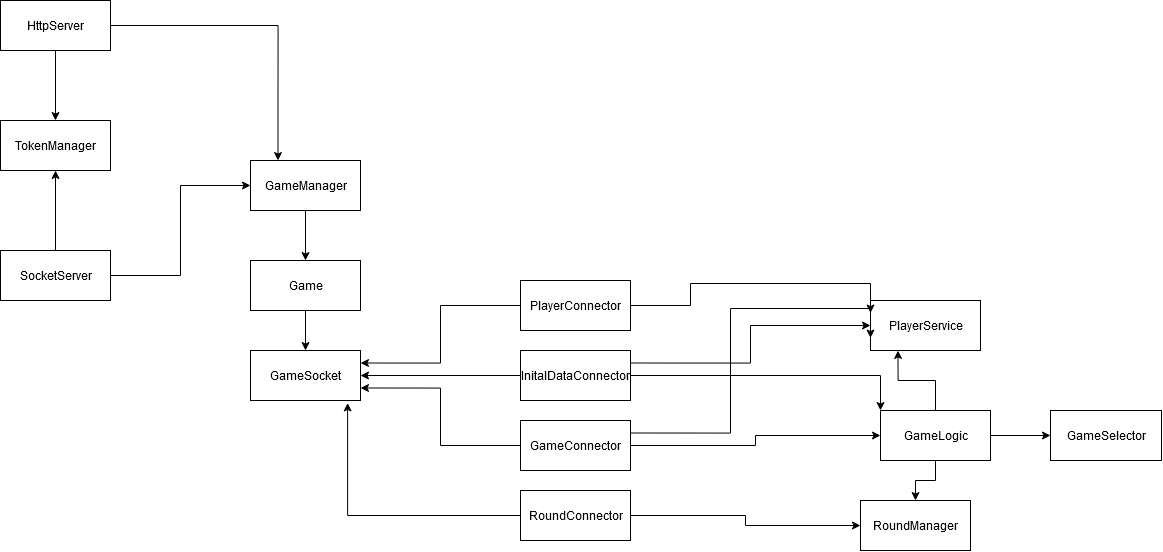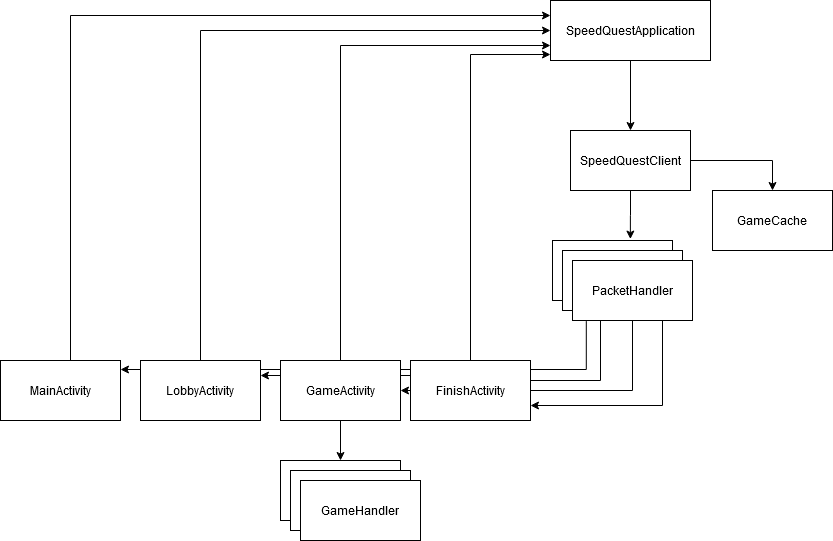SpeedQuest is a collection of mini-games. It is an online competition between players in a lobby, where players get rated by their performance.
SpeedQuest uses a simple Client-Server architecture. The server assigns tasks and keeps track of each player's score. It enables the client to broadcast custom packets, send information and receive real-time updates. Minigames get rated client-side, whereas the server processes those ratings and translates them into a specific score.
The SpeedQuest server is a NodeJS-server that uses WebSocket. The repository can be found here.
The main network handling is done with the SpeedQuestClient. Therefore the app communicates via WebSocket and Json-Packets. Packets can dynamically be registered without modifying the actual client.
The SpeedQuestclient can be accessed from any activity.
SpeedQuestClient client = ((SpeedQuestApplication)getApplication()).client;The registration of new packets enables a fast development of new real-time games and other features. To register a new packet, a new java class is required.
Make sure, that the specified class is serializable via Gson:2.8.6. Every packet-class needs to extend the abstract class Packet.
Every packet is identified by an unique name. The name needs to be specified with a custom annotation PacketID.
To be able to send the packet, the protected String packetID needs to be set in the constructor.
// To be able to identify the incoming packet
@PacketID("example")
public class PacketExample extends Packet {
@SerializedName("var1")
private String var1;
public PacketExample() {
// To be able to send the packet correctly
super.packetID = "example";
}
}The packet is now ready to be registered. This will tell the SpeedQuestClient how to deserialize an incoming json with the id example.
client.registerPacket(PacketExample.class);Now, the SpeedQuestClient is able to deserialize the new packet. To evaluate the incoming example-packets, a PacketHandler is needed. PacketHandlers can be registered simultaneously with the packets.
client.registerPacketHandler(this::exampleHandler, PacketExample.class, MyActivity.this, myUUID);The activity and id are optional parameters. If the activity is specified, the callback will be performed in the UI-Thread of the activity. Furthermore, all packet-handlers of a certain activity can be unregistered at once. This is important, if the activity is stopped or destroyed to prevent duplicate listeners. Packet-handlers can be grouped via an ID. This is important if you have temporary handlers like minigames, that should be unregistered after they finished.
Packet-handlers can be unregistered via activity or id.
client.unregisterMappingsOfActivity(MyActivity.this);
client.unregisterMappingsOfID(handlerGroupID);Also, certain packet handlers can be removed.
client.unregisterPacketMappings(PacketExample.class);The SpeedQuestClient contains a game-cache. Important information like the player-list, active tasks and game-states are stored here. This ensures availability of the information independent of the underlying context.
GameCache cache = client.getGameCache();SpeedQuest contains a lot of independent games. Therefore, a general game-handling-system was developed to easily add games.
Each game has a specific resource (UI), that will be shown during the game. All games are displayed in the IngameActivity and will be dynamically inflated.
The game-logic will be handled by an individual GameHandler.
public class MyExampleGameHandler extends GameHandler {
public MyExampleGameHandler(IngameActivity activity) {
super(activity);
// Do not initialize stuff here. Use initialize(...)
}
@Override
public int getGameResource() {
// The custom game-ui (for example a ConstraintLayout)
return R.layout.game_my_example;
}
@Override
public void initialize(View inflatedView, TaskInfo task) {
// TODO: Initialize button click listeners, timers etc.
// Params can be found in TaskInfo
}
@Override
public void registerPacketHandlers() {
SpeedQuestClient client = ((SpeedQuestApplication)activity.getApplication()).client;
client.registerPacketHandler(this::handleMyExample, PacketMyExample.class, activity, getHandlerID());
}
@Override
public void onEnd() {
// Will be called when the server ends the game (not when called finish(...))
// TODO: Unregister listeners (like schedulers)
// PacketHandlers will be automatically unregistered (if HandlerID was provided)
}
private void handleMyExample(PacketMyExample packet, SpeedQuestClient client) {
// TODO: Handle custom packet
sendScore(100); // Sends a score-update to the server (asynchronously)
finish(100); // Sends the final score to the server (can only be called once)
}
}To register the game, it must be added to the IngameActivity in the method addAvailableHandlers().
private void addAvailableHandlers() {
// other game registrations...
availableHandlers.put("myexample", new MyExampleGameHandler(this));
}That is everything you need to do to successfully register a new game. The only thing that needs to be done is to register the custom game at the server. This can also be done dynamically by editing a config-file.

